Guido C. H. E. de Croon
One Net to Rule Them All: Domain Randomization in Quadcopter Racing Across Different Platforms
Apr 30, 2025Abstract:In high-speed quadcopter racing, finding a single controller that works well across different platforms remains challenging. This work presents the first neural network controller for drone racing that generalizes across physically distinct quadcopters. We demonstrate that a single network, trained with domain randomization, can robustly control various types of quadcopters. The network relies solely on the current state to directly compute motor commands. The effectiveness of this generalized controller is validated through real-world tests on two substantially different crafts (3-inch and 5-inch race quadcopters). We further compare the performance of this generalized controller with controllers specifically trained for the 3-inch and 5-inch drone, using their identified model parameters with varying levels of domain randomization (0%, 10%, 20%, 30%). While the generalized controller shows slightly slower speeds compared to the fine-tuned models, it excels in adaptability across different platforms. Our results show that no randomization fails sim-to-real transfer while increasing randomization improves robustness but reduces speed. Despite this trade-off, our findings highlight the potential of domain randomization for generalizing controllers, paving the way for universal AI controllers that can adapt to any platform.
Self-Supervised Monocular Visual Drone Model Identification through Improved Occlusion Handling
Apr 30, 2025



Abstract:Ego-motion estimation is vital for drones when flying in GPS-denied environments. Vision-based methods struggle when flight speed increases and close-by objects lead to difficult visual conditions with considerable motion blur and large occlusions. To tackle this, vision is typically complemented by state estimation filters that combine a drone model with inertial measurements. However, these drone models are currently learned in a supervised manner with ground-truth data from external motion capture systems, limiting scalability to different environments and drones. In this work, we propose a self-supervised learning scheme to train a neural-network-based drone model using only onboard monocular video and flight controller data (IMU and motor feedback). We achieve this by first training a self-supervised relative pose estimation model, which then serves as a teacher for the drone model. To allow this to work at high speed close to obstacles, we propose an improved occlusion handling method for training self-supervised pose estimation models. Due to this method, the root mean squared error of resulting odometry estimates is reduced by an average of 15%. Moreover, the student neural drone model can be successfully obtained from the onboard data. It even becomes more accurate at higher speeds compared to its teacher, the self-supervised vision-based model. We demonstrate the value of the neural drone model by integrating it into a traditional filter-based VIO system (ROVIO), resulting in superior odometry accuracy on aggressive 3D racing trajectories near obstacles. Self-supervised learning of ego-motion estimation represents a significant step toward bridging the gap between flying in controlled, expensive lab environments and real-world drone applications. The fusion of vision and drone models will enable higher-speed flight and improve state estimation, on any drone in any environment.
Design and Control of A Tilt-Rotor Tailsitter Aircraft with Pivoting VTOL Capability
Mar 04, 2025Abstract:Tailsitter aircraft attract considerable interest due to their capabilities of both agile hover and high speed forward flight. However, traditional tailsitters that use aerodynamic control surfaces face the challenge of limited control effectiveness and associated actuator saturation during vertical flight and transitions. Conversely, tailsitters relying solely on tilting rotors have the drawback of insufficient roll control authority in forward flight. This paper proposes a tilt-rotor tailsitter aircraft with both elevons and tilting rotors as a promising solution. By implementing a cascaded weighted least squares (WLS) based incremental nonlinear dynamic inversion (INDI) controller, the drone successfully achieved autonomous waypoint tracking in outdoor experiments at a cruise airspeed of 16 m/s, including transitions between forward flight and hover without actuator saturation. Wind tunnel experiments confirm improved roll control compared to tilt-rotor-only configurations, while comparative outdoor flight tests highlight the vehicle's superior control over elevon-only designs during critical phases such as vertical descent and transitions. Finally, we also show that the tilt-rotors allow for an autonomous takeoff and landing with a unique pivoting capability that demonstrates stability and robustness under wind disturbances.
Multi-objective Evolution of Drone Morphology
Feb 03, 2025



Abstract:The design of multicopter drones has remained almost the same since its inception. While conventional designs, such as the quadcopter, work well in many cases, they may not be optimal in specific environments or missions. This paper revisits rotary drone design by exploring which body morphologies are optimal for different objectives and constraints. Specifically, an evolutionary algorithm is used to produce optimal drone morphologies for three objectives: (1) high thrust-to-weight ratio, (2) high maneuverability, and (3) small size. To generate a range of optimal drones with performance trade-offs between them, the non-dominated sorting genetic algorithm II, or NSGA-II is used. A randomly sampled population of 600 is evolved over 2000 generations. The NSGA-II algorithm evolved drone bodies that outperform a standard 5-inch 220 mm wheelbase quadcopter in at least one of the three objectives. The three extrema in the Pareto front show improvement of 487.8%, 23.5% and 4.8% in maneuverability, thrust-to-weight ratio and size, respectively. The improvement in maneuverability can be attributed to the tilt angles of the propellers, while the increase in thrust-to-weight ratio is primarily due to the higher number of propellers. The quadcopter is located on the Pareto front for the three objectives. However, our results also show that other designs can be better depending on the objectives.
Cooperative Relative Localization in MAV Swarms with Ultra-wideband Ranging
May 28, 2024



Abstract:Relative localization (RL) is essential for the successful operation of micro air vehicle (MAV) swarms. Achieving accurate 3-D RL in infrastructure-free and GPS-denied environments with only distance information is a challenging problem that has not been satisfactorily solved. In this work, based on the range-based peer-to-peer RL using the ultra-wideband (UWB) ranging technique, we develop a novel UWB-based cooperative relative localization (CRL) solution that integrates the relative motion dynamics of each host-neighbor pair to build a unified dynamic model and takes the distances between the neighbors as \textit{bonus information}. Observability analysis using differential geometry shows that the proposed CRL scheme can expand the observable subspace compared to other alternatives using only direct distances between the host agent and its neighbors. In addition, we apply the kernel-induced extended Kalman filter (EKF) to the CRL state estimation problem with the novel-designed Logarithmic-Versoria (LV) kernel to tackle heavy-tailed UWB noise. Sufficient conditions for the convergence of the fixed-point iteration involved in the estimation algorithm are also derived. Comparative Monte Carlo simulations demonstrate that the proposed CRL scheme combined with the LV-kernel EKF significantly improves the estimation accuracy owing to its robustness against both measurement outliers and incorrect measurement covariance matrix initialization. Moreover, with the LV kernel, the estimation is still satisfactory when performing the fixed-point iteration only once for reduced computational complexity.
End-to-end Reinforcement Learning for Time-Optimal Quadcopter Flight
Nov 28, 2023



Abstract:Aggressive time-optimal control of quadcopters poses a significant challenge in the field of robotics. The state-of-the-art approach leverages reinforcement learning (RL) to train optimal neural policies. However, a critical hurdle is the sim-to-real gap, often addressed by employing a robust inner loop controller -an abstraction that, in theory, constrains the optimality of the trained controller, necessitating margins to counter potential disturbances. In contrast, our novel approach introduces high-speed quadcopter control using end-to-end RL (E2E) that gives direct motor commands. To bridge the reality gap, we incorporate a learned residual model and an adaptive method that can compensate for modeling errors in thrust and moments. We compare our E2E approach against a state-of-the-art network that commands thrust and body rates to an INDI inner loop controller, both in simulated and real-world flight. E2E showcases a significant 1.39-second advantage in simulation and a 0.17-second edge in real-world testing, highlighting end-to-end reinforcement learning's potential. The performance drop observed from simulation to reality shows potential for further improvement, including refining strategies to address the reality gap or exploring offline reinforcement learning with real flight data.
AOSoar: Autonomous Orographic Soaring of a Micro Air Vehicle
Aug 01, 2023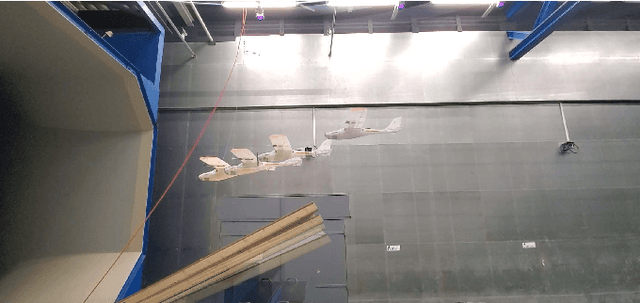


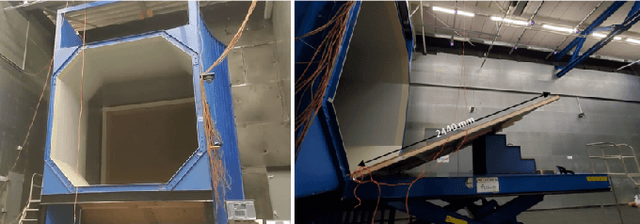
Abstract:Utilizing wind hovering techniques of soaring birds can save energy expenditure and improve the flight endurance of micro air vehicles (MAVs). Here, we present a novel method for fully autonomous orographic soaring without a priori knowledge of the wind field. Specifically, we devise an Incremental Nonlinear Dynamic Inversion (INDI) controller with control allocation, adapting it for autonomous soaring. This allows for both soaring and the use of the throttle if necessary, without changing any gain or parameter during the flight. Furthermore, we propose a simulated-annealing-based optimization method to search for soaring positions. This enables for the first time an MAV to autonomously find a feasible soaring position while minimizing throttle usage and other control efforts. Autonomous orographic soaring was performed in the wind tunnel. The wind speed and incline of a ramp were changed during the soaring flight. The MAV was able to perform autonomous orographic soaring for flight times of up to 30 minutes. The mean throttle usage was only 0.25% for the entire soaring flight, whereas normal powered flight requires 38%. Also, it was shown that the MAV can find a new soaring spot when the wind field changes during the flight.
Autonomous Control for Orographic Soaring of Fixed-Wing UAVs
May 23, 2023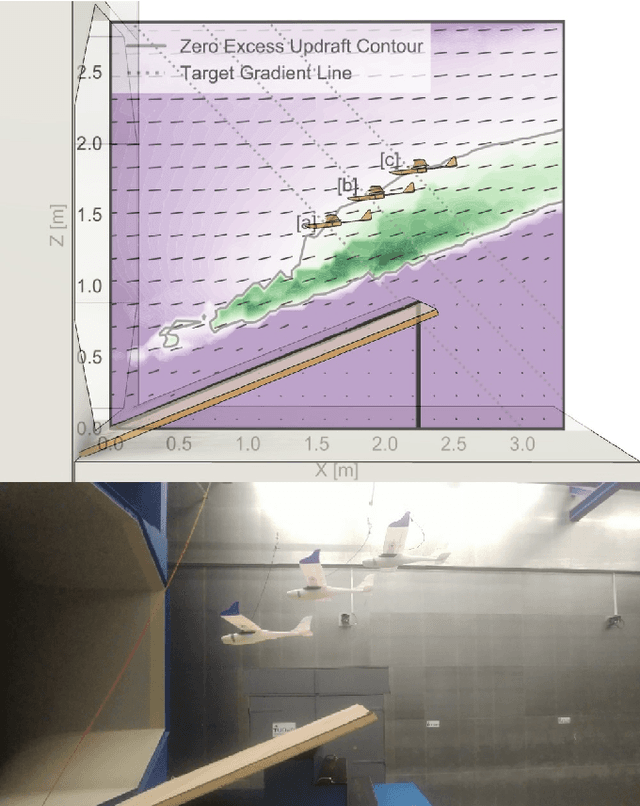
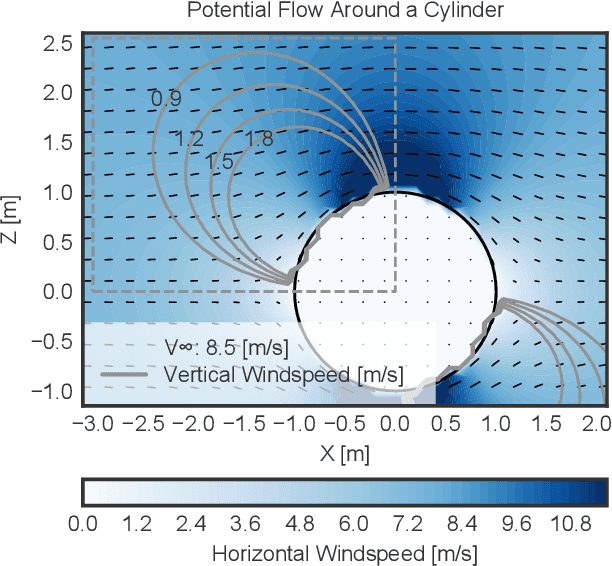
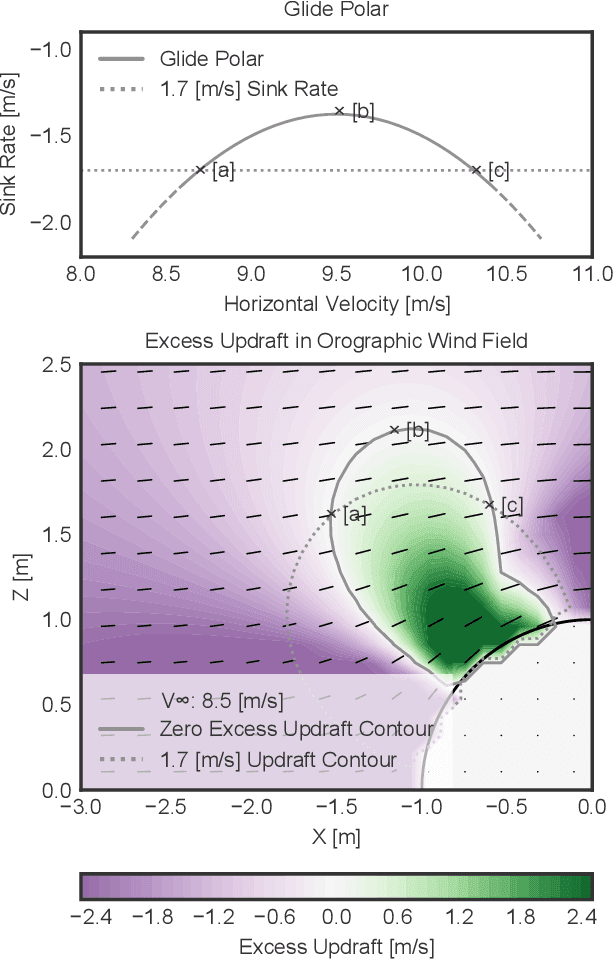
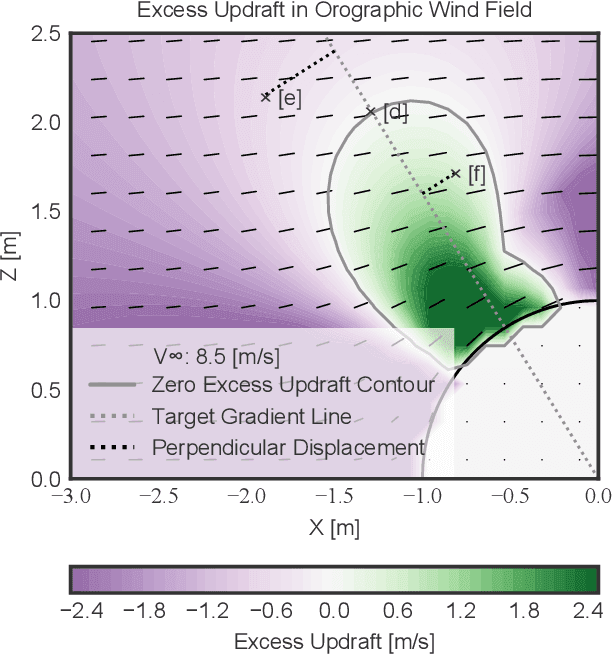
Abstract:We present a novel controller for fixed-wing UAVs that enables autonomous soaring in an orographic wind field, extending flight endurance. Our method identifies soaring regions and addresses position control challenges by introducing a target gradient line (TGL) on which the UAV achieves an equilibrium soaring position, where sink rate and updraft are balanced. Experimental testing validates the controller's effectiveness in maintaining autonomous soaring flight without using any thrust in a non-static wind field. We also demonstrate a single degree of control freedom in a soaring position through manipulation of the TGL.
Optimality Principles in Spacecraft Neural Guidance and Control
May 22, 2023Abstract:Spacecraft and drones aimed at exploring our solar system are designed to operate in conditions where the smart use of onboard resources is vital to the success or failure of the mission. Sensorimotor actions are thus often derived from high-level, quantifiable, optimality principles assigned to each task, utilizing consolidated tools in optimal control theory. The planned actions are derived on the ground and transferred onboard where controllers have the task of tracking the uploaded guidance profile. Here we argue that end-to-end neural guidance and control architectures (here called G&CNets) allow transferring onboard the burden of acting upon these optimality principles. In this way, the sensor information is transformed in real time into optimal plans thus increasing the mission autonomy and robustness. We discuss the main results obtained in training such neural architectures in simulation for interplanetary transfers, landings and close proximity operations, highlighting the successful learning of optimality principles by the neural model. We then suggest drone racing as an ideal gym environment to test these architectures on real robotic platforms, thus increasing confidence in their utilization on future space exploration missions. Drone racing shares with spacecraft missions both limited onboard computational capabilities and similar control structures induced from the optimality principle sought, but it also entails different levels of uncertainties and unmodelled effects. Furthermore, the success of G&CNets on extremely resource-restricted drones illustrates their potential to bring real-time optimal control within reach of a wider variety of robotic systems, both in space and on Earth.
Guidance & Control Networks for Time-Optimal Quadcopter Flight
May 04, 2023



Abstract:Reaching fast and autonomous flight requires computationally efficient and robust algorithms. To this end, we train Guidance & Control Networks to approximate optimal control policies ranging from energy-optimal to time-optimal flight. We show that the policies become more difficult to learn the closer we get to the time-optimal 'bang-bang' control profile. We also assess the importance of knowing the maximum angular rotor velocity of the quadcopter and show that over- or underestimating this limit leads to less robust flight. We propose an algorithm to identify the current maximum angular rotor velocity onboard and a network that adapts its policy based on the identified limit. Finally, we extend previous work on Guidance & Control Networks by learning to take consecutive waypoints into account. We fly a 4x3m track in similar lap times as the differential-flatness-based minimum snap benchmark controller while benefiting from the flexibility that Guidance & Control Networks offer.
 Add to Chrome
Add to Chrome Add to Firefox
Add to Firefox Add to Edge
Add to Edge